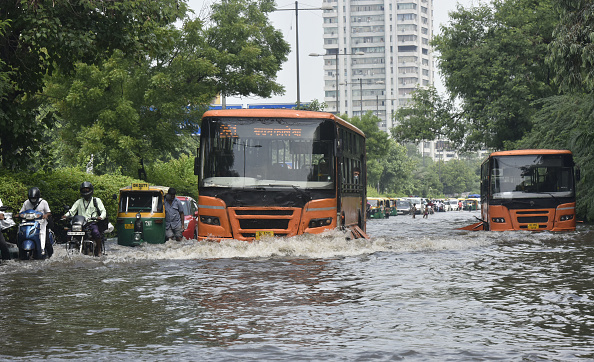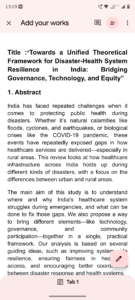By Theresa Jose
Delhi is a very densely populated city and there has been a growth of informal settlements throughout the city which has led to many urban challenges including waterlogging. These challenges mainly arise due to poor urban planning by the civic authorities which is creating a nightmare for the people living in the city. Especially in the areas which are the main hubs of the UPSC coaching centres like Karol Bagh, Patel Nagar and Rajinder Nagar which have recently been in the media for the concerns raised by the residents and people on the issues of exposed open wires, overflow of manholes and sewage and the problem of high rents but with poor facilities. This lack of quality living conditions has increased the demand for affordable study spaces for students, resulting in many libraries being set up in basements (Bhandari, 2024). So when the new centre of Rau’s IAS was established in the Old Rajinder Nagar on the request of the students they also set up a library that was illegally operating in the basement of the building which was supposed to be utilised for parking and storage (Menon, 2024).
On July 27th night, heavy rainfall led to waterlogging in Old Rajinder Nagar. The high force of water led to it entering the basement of Rau’s IAS Study Circle in Old Rajinder Nagar and this led to flooding in the library which had 30 students in it but only 27 managed to escape or were rescued by the fire department, National Disaster Response Force (NDRF) and Delhi Police while the 3 UPSC aspirants who were trapped lost their lives (Tewari, 2024; ET Online, 2024). The gross negligence by the MCD officials was brought to light by the revelation that a month before this tragic incident a student from the coaching centre filed a complaint regarding the illegally operating library in the basement but the authorities did not take any appropriate actions (Herald, 2024). The negligence of the MCD officials was strongly reprimanded by the Delhi High Court (The Hindu Bureau, 2024). In the aftermath, immediate actions were taken by the Municipal Corporation of Delhi (MCD) including shutting off at least 13 coaching centres which were violating the rules under the Delhi Master Plan 2021 which mandates statutory clearance to use the basement and was strongly against using the basement for commercial purposes (Sharma, 2024; Tewari, 2024).
In Old Rajinder Nagar the property owners construct buildings which cover the drains which is also a common issue in Delhi as revealed by the MCD’s investigation. This obstruction by buildings on the drains has made it difficult to clean the drains and also affects the flow of stormwater which results in waterlogging. So there is a need to implement legislative frameworks like the ‘Storm Water and Drainage Act for the NCT of Delhi’ which emphasizes preventing any future illegal barrier on the city’s drainage system (Press Trust of India & Business Standard, 2024). The Coaching Centre tragedy is alleged to be mainly due to the inefficient drainage system and the violation of the building laws but this is not an isolated incident. 27 people’s lives were claimed due to electrocution past year as per the reports (Ujwal Jalali et al., 2024). On July 22nd, a UPSC aspirant was electrocuted when he slipped while walking on a waterlogged street of Patel Nagar and held on to an iron gate which was in contact with an exposed motor wire (Tewari, 2024). The city also witnessed an incident where two fires broke out in Mukherjee Nagar last year which resulted in 61 students of a caching centre injured, the latter incident led to the fire department conducting a survey which showed that 461 coaching centres did not have any proper safety measures (Tewari, 2024). All this put the city’s civic body authorities in the spotlight for their failure to address the urban crisis that has been affecting the city’s residents and their lack of action against the violation of building regulations.
The solution to the recent waterlogging in the capital city when there are heavy downpours is not just by desilting the drains which is just a temporary solution but also through revamping the city’s drainage system which could help prevent the recurring waterlogging in the long term. However, the construction of a new drainage system that has to be suitable for the densely populated and unplanned colonies of Delhi could be a task that needs at least 4 years to be fulfilled and large investments (Mathur, 2024). When it comes to funds required to implement the new project the city authorities don’t have enough because of the freebie culture that is supported by the government which keeps the revamping of the city’s infrastructure on hold and this action of the government was strongly reprimanded by the Delhi High Court. Presently the existing drainage system of the city faces problems like outdated design with the sewerage system being combined and the inability of the system to handle heavy rains as the existing one’s designed to only handle 50 mm of rainwater within 24 hours in a city which has witnessed a downpour of 228 mm of rainwater in a day which underscores the immediate need to design a drainage system which could help handle more water and lessen the vulnerability of the city to the monsoon waterlogging crisis (Ujwal Jalali et al., 2024).
The sewerage system is of two types, combined and separate sewerage with the former which carry both the stormwater and wastewater together while the latter carries both separately. Currently, separate sewage systems are in demand as they help in controlling the stormwater separately, prevent combined sewer overflow and stop sewage from getting into the environment. This could help in avoiding flooding during heavy downpours in low-lying areas, even after this flooding occurs it would just be rainwater and not sewage waste which could spread diseases (Stauffer & Spuhler, n.d.). However, there is a downside to the construction of a separate sewerage system, it is costly and if the sewer is not separated properly it can increase pollutants in the water due to the discharge of untreated surface run-off. This is seen mainly in highly urbanised areas where the stormwater drains get mixed with pollutants from industrial sites, rooftops etc and this highlights the need for strict inspection and effective construction which could prevent pollution from these sources (Stauffer & Spuhler, n.d.).
A lack of stormwater conservation measures like wetlands, ponds, parks, water bodies and open spaces in the unplanned settlements of Delhi is seen to be the primary reason for flooding in the city. To prevent this from happening initial plan is to take proper action by implementing rainwater conservation in the upper parts of the watersheds because controlling the flow from upstream will help in addressing the flooding downstream. Major factors that result in heavy rainfall that lead to waterlogging in Delhi are climate change and rapid unplanned urbanization. To control this a combined approach of conservation and stormwater drainage is proposed (Depinder Kapur et al., 2024).
The coaching centre tragedy which has shaken the capital city has demanded accountability and changes in the administrative system so that similar incidents can be avoided in the future. The students who lost their lives also had dreamt of being a part of the administrative system, the same system that failed them.
So there is a need to priroitize inclusive urban planning and strictly enforce essential building laws and it is also important to bear in mind that everyone in the city that everyone irrespective of socio-economic status has a right to a city which provides a safety and quality life.
Reference
Bhandari, H. (2024, July 30). Expensive PGs force UPSC aspirants to seek refuge in basement libraries. Hindustan Times. https://www.hindustantimes.com/cities/delhi-news/expensive-pgs-force-upsc-aspirants-to-seek-refuge-in-basement-libraries-101722364389398.html
Depinder Kapur, Pradeep Kumar Mishra, Umra Anees, Jyoti Prasad & Amit Choudhary (2024, July 15). Why does Delhi flood? The answer lies in our urban stormwater management. Down to Earth. https://www.downtoearth.org.in/water/why-does-delhi-flood-the-answer-lies-in-our-urban-stormwater-management
ET Online (2024, July 28). Pushed by water, basement door collapsed: How tragedy unfolded at Rau’s IAS Coaching Centre claiming three. The Economic Times. https://economictimes.indiatimes.com/news/india/pushed-by-water-basement-door-collapsed-how-the-tragedy-unfolded-at-raus-ias-coaching-centre-claiming-three-lives/articleshow/112075228.cms?from=mdr
Herald, T. (2024, August 1). Delhi’s IAS aspirants’ death a systemic failure. Heraldgoa. https://www.heraldgoa.in/Edit/Editorial/Delhi%E2%80%99s-IAS-aspirants%E2%80%99-death-a-systemic-failure/224252
Mathur, S. M. (2024, June 30). New drainage system for Delhi need of the hour. The Times of India. https://timesofindia.indiatimes.com/city/delhi/new-drainage-system-for-capital-need-of-the-hour/articleshow/111372716.cms
Menon, V. (2024b, July 30). Rau’s IAS was an elite, small-batch institute. Then, competition led to rapid expansion. ThePrint. https://theprint.in/ground-reports/raus-ias-was-an-elite-small-batch-institute-then-competition-led-to-rapid-expansion/2196850/
Press Trust of India & Business Standard. (2024, August 1). Encroachment of drains widespread, the law needed to tackle the problem: Delhi CS. www.business-standard.com. https://www.business-standard.com/india-news/encroachment-of-drains-widespread-law-needed-to-tackle-problem-delhi-cs-124073101774_1.html
Sharma, N. (2024, July 29). UPSC aspirants’ deaths: 13 coaching centres sealed amid protests, PIL filed, matter reaches Parliament. ThePrint. https://theprint.in/india/upsc-aspirants-deaths-13-coaching-centres-sealed-amid-protests-pil-filed-matter-reaches-parliament/2196198/
Singh, R. K. (2024, June 30). Here’s why Delhi faces repeated waterlogging every monsoon. India Today. https://www.indiatoday.in/cities/delhi/story/delhi-waterlogging-flooding-monsoon-rains-2560487-2024-07-01
Stauffer, B., & Spuhler, D. (n.d.). Separate sewers. SSWM – Find Tools for Sustainable Sanitation and Water Management. https://sswm.info/sswm-university-course/module-2-centralised-and-decentralised-systems-water-and-sanitation/further/separate-sewers
Tewari, S. (2024, August 1). Dreams and despair in Delhi’s UPSC hub. The Hindu. https://www.thehindu.com/news/cities/Delhi/dreams-and-despair-in-delhis-upsc-hub/article68472944.ece
The Hindu Bureau. (2024, July 31). Delhi coaching centre deaths: Delhi HC pulls up authorities, slams freebies culture. The Hindu. https://www.thehindu.com/news/national/coaching-centre-deaths-delhi-hc-pulls-up-authorities-slams-freebies-culture/article68467943.ece
Ujwal Jalali, Anup Verma, Shekhar Singh, Prabhat Shukla. (2024, July 29). Delhi in a lethal urban crisis. The New Indian Express.https://www.newindianexpress.com/cities/delhi/2024/Jul/29/delhi-in-a-lethal-urban-crisis






